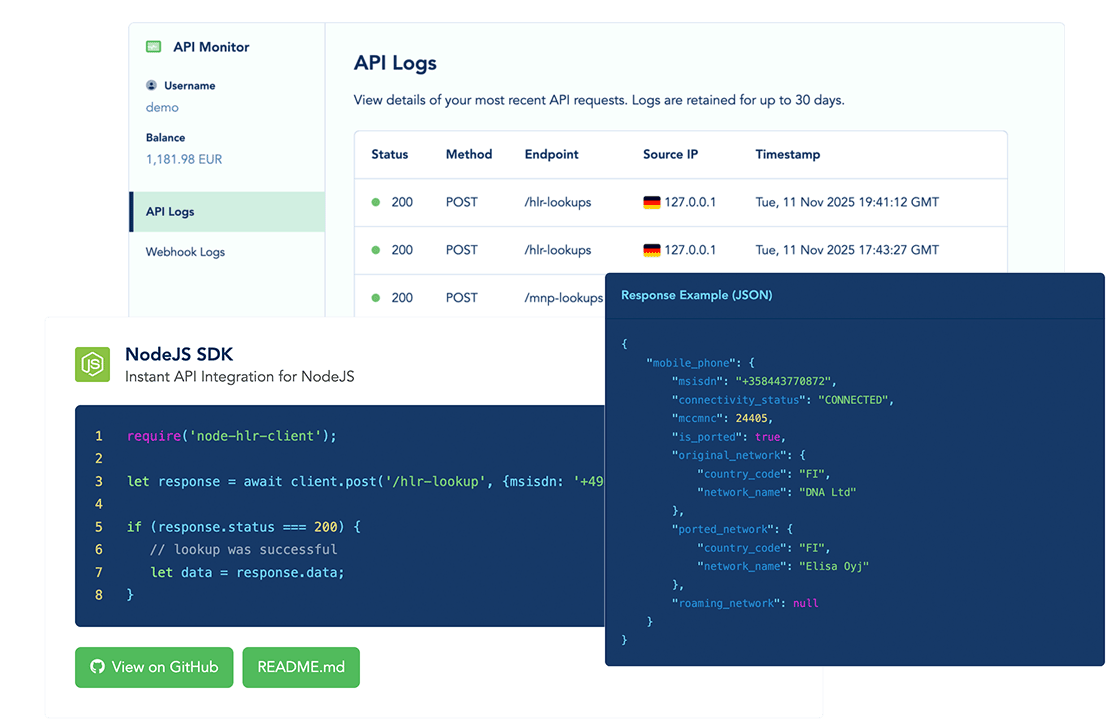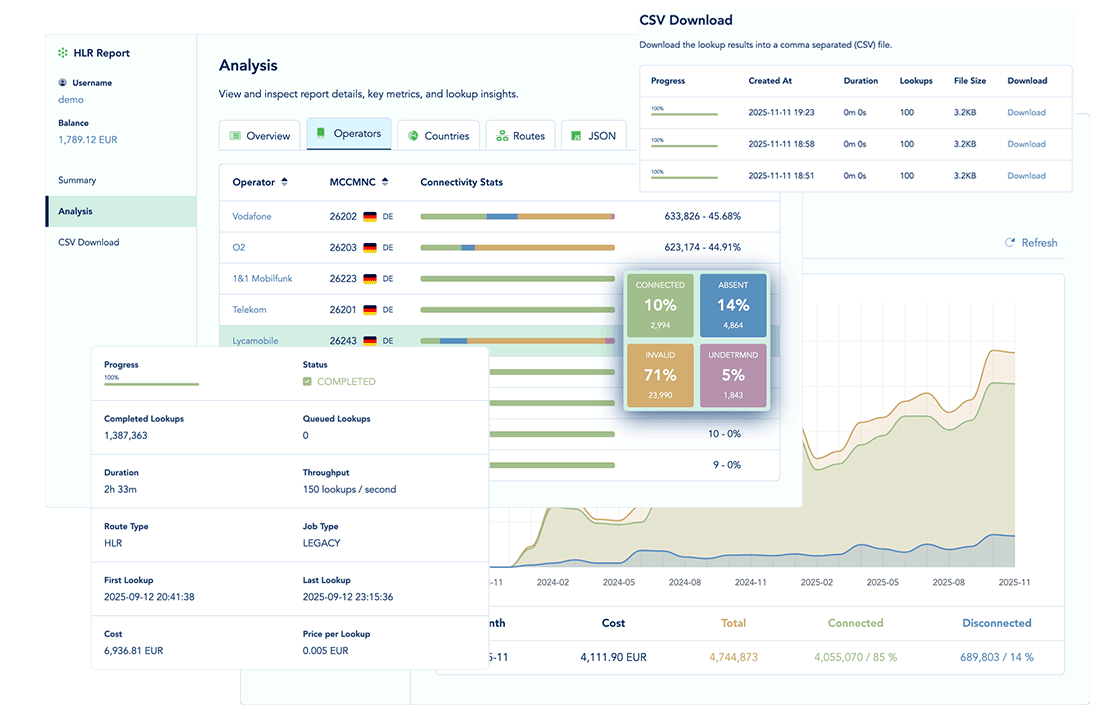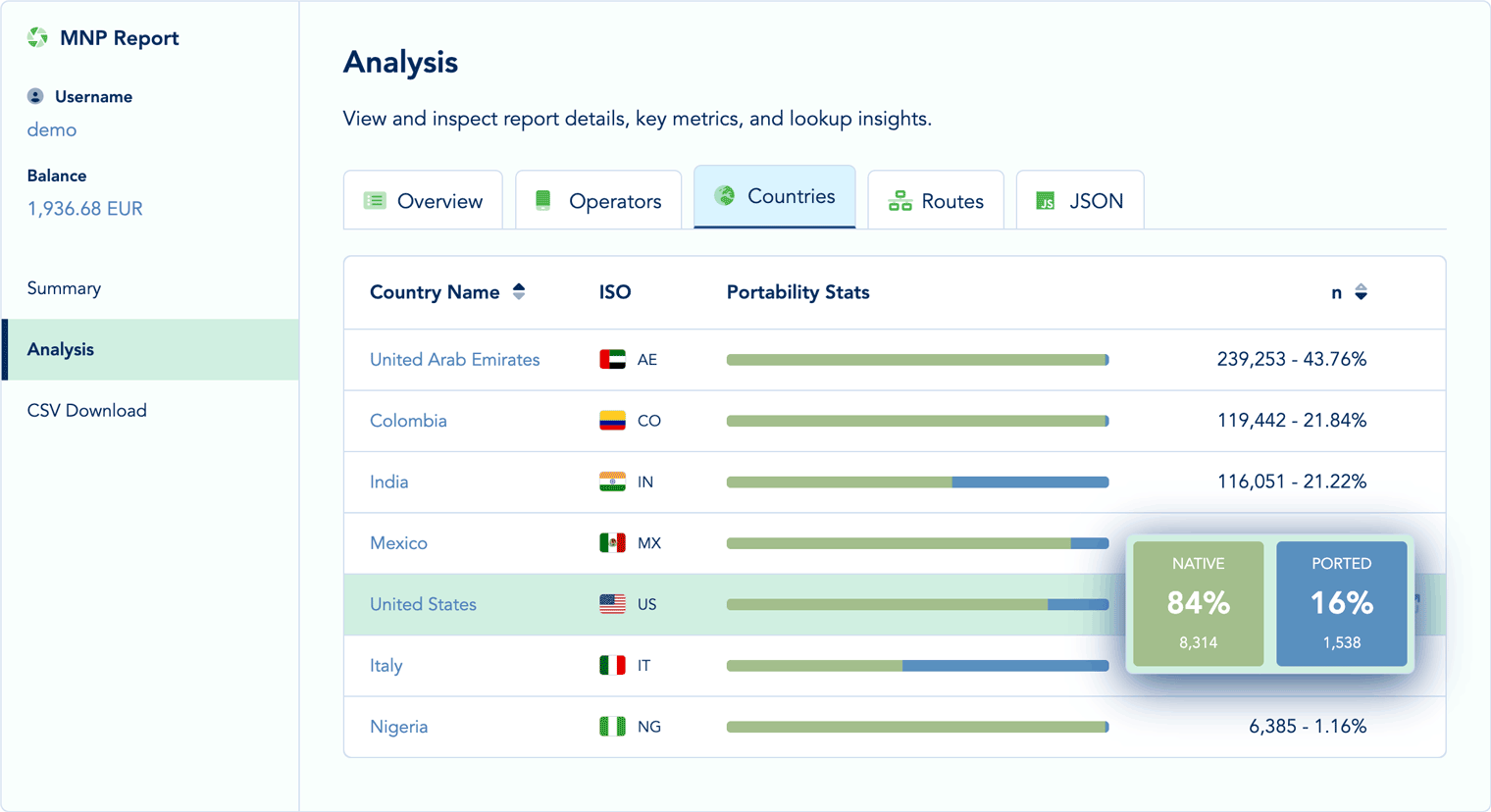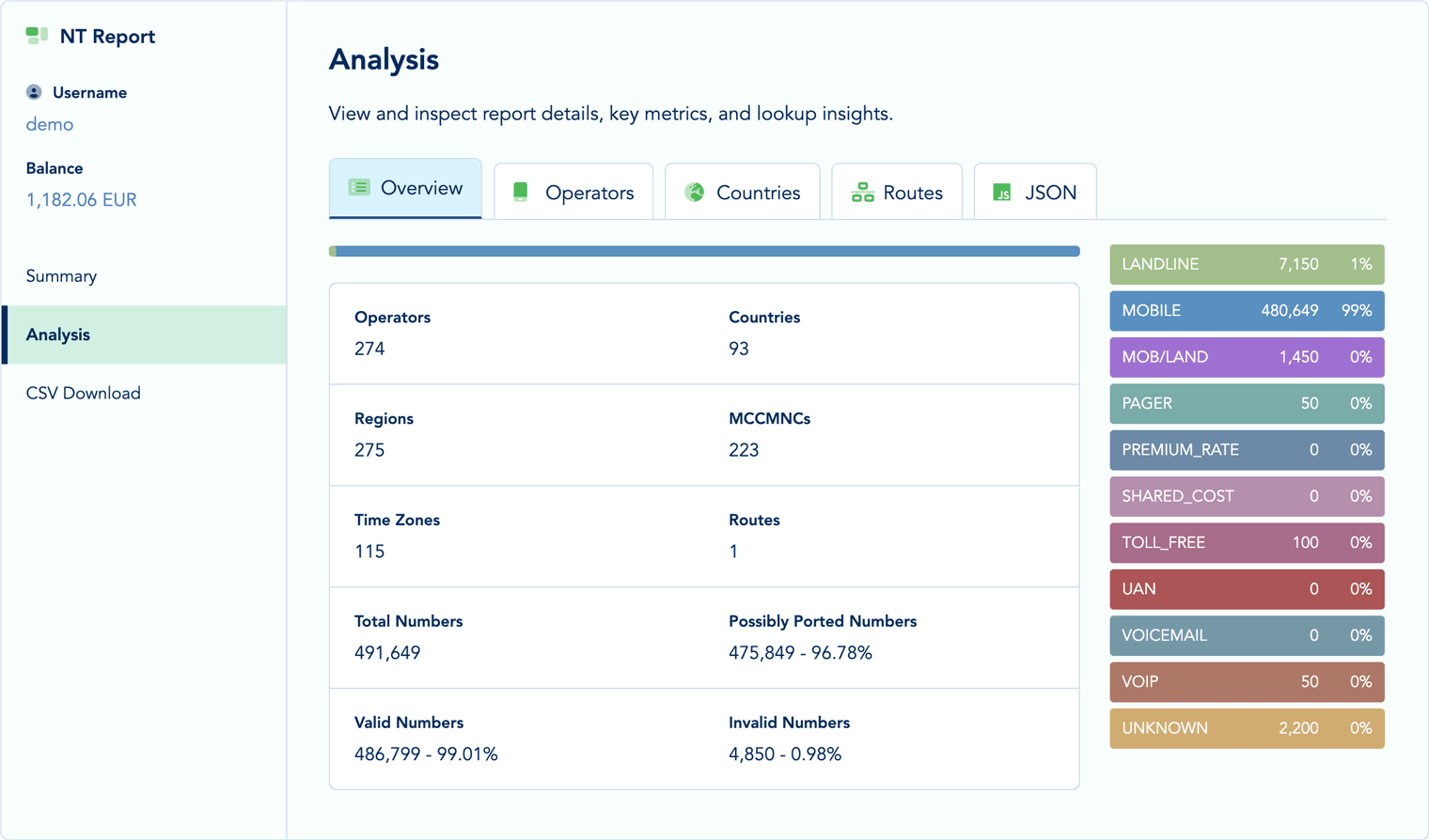Submit mobile phone numbers via the Enterprise Web Client, the HTTP REST API, file upload, or SDKs. We then query the SS7 signaling network, retrieve real-time data from the relevant mobile network operator (MNO), and deliver detailed reports in JSON, HTML, PDF, or CSV format—processing up to 5k results per second.
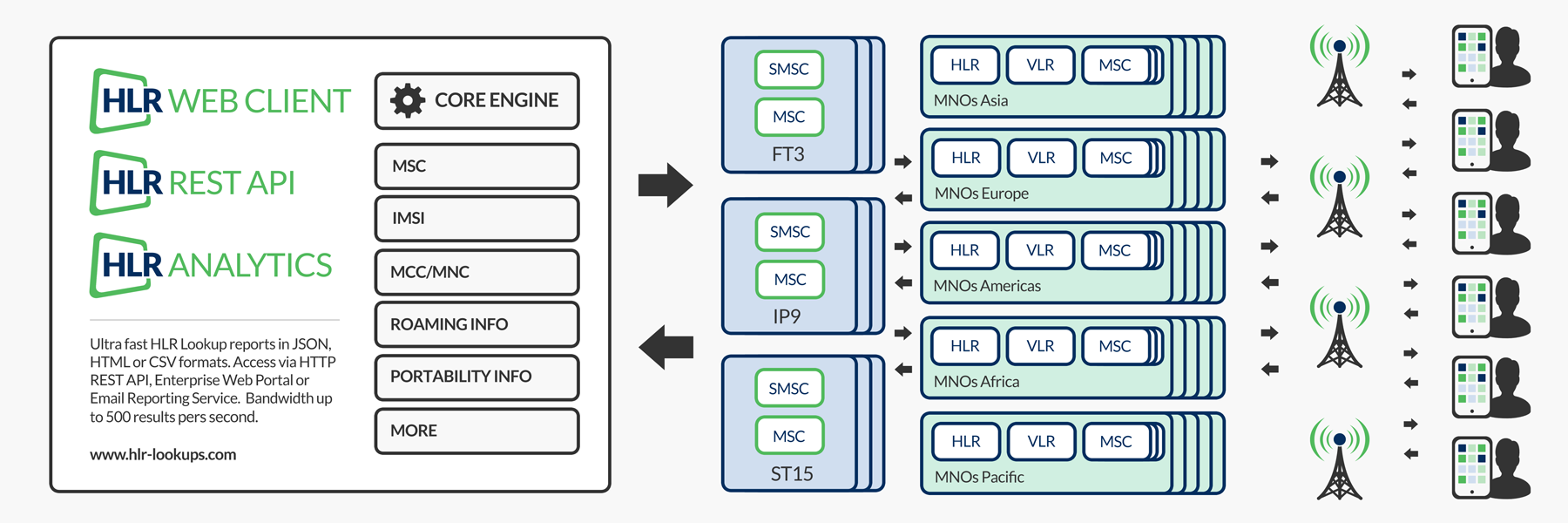
What is an HLR Lookup?
HLR Lookup is a powerful technology that verifies the status of any GSM mobile number in real time
By querying the Home Location Register (HLR), a lookup determines whether a number is valid, active on a mobile network, and, if so, identifies the associated network. It also detects whether the number has been ported from another network or is currently roaming. Additionally, the lookup provides essential metadata, including the MCCMNC code.
Our Enterprise HLR Lookup Platform and API are built for reliability and scalability, offering redundant access to a global network of SMS centers and multiple geographically distributed connections to the SS7 mobile signaling network. Designed for high-speed, real-time performance, our system efficiently processes large batches of mobile phone lookups across more than 200 countries with exceptional accuracy.
Learn more about HLR Lookups
Additional Platform Features
Comprehensive Mobile Number Intelligence Beyond HLR Lookups
Mobile Number Portability (MNP) Lookups
While HLR Lookups query the SS7 signaling network in real time, our MNP Lookup service provides instant access to network and portability information from national numbering plan databases. MNP Lookups offer a cost-effective alternative for identifying the current carrier of a mobile number without querying the live network. This service is ideal for bulk database cleansing, validating phone number assignments, and routing optimization where real-time connectivity status is not required.
Our MNP Lookup platform covers over 200 countries and provides immediate results for determining whether a number has been ported, identifying the original and current network operators, and retrieving essential network identifiers. This service integrates seamlessly with our APIs and web client, offering the same enterprise-grade reliability and performance as our HLR Lookup platform.
Learn more about MNP Lookups
Number Type (NT) Lookups
Our Number Type Lookup service provides intelligent phone number classification through static number analysis, identifying whether a number is a mobile, landline, VoIP, or other telecommunications service type. This powerful feature enables businesses to segment their contact databases, optimize communication strategies, and ensure compliance with telecommunications regulations.
NT Lookups are particularly valuable for contact centers, marketing teams, and messaging providers who need to distinguish between mobile and landline numbers before initiating campaigns. By identifying number types in advance, organizations can route SMS messages exclusively to mobile numbers, direct voice calls appropriately, and avoid costly errors associated with sending SMS to landlines or calling VoIP services.
Learn more about NT Lookups
Designed for Developers
Accelerate development with our robust, user-friendly HLR Lookup APIs.
Streamline your development process with our powerful API, designed to handle the complexities of global mobile networks. Our service enables you to validate phone numbers, check real-time connectivity status, and retrieve critical network details with ease.
Whether integrating HLR lookups into your software, automating data verification, or optimizing messaging delivery, our API ensures seamless access to accurate mobile subscriber data.
Read the DocsSoftware Development Kits
Key Data Points Extracted from HLR Lookups
Actionable Insights from Mobile Network Intelligence
Current Mobile Network
Identify the mobile network operator a number is currently registered with, ensuring accurate routing and verification.
Phone Status
Determine if a phone is switched on, unreachable, or experiencing temporary network issues that could delay SMS delivery.
Network Identifiers
Retrieve key network identifiers like the MCCMNC to gain deep insights into a number’s carrier information.
Number Validity
Confirm if a number is active, deactivated, or was never registered, helping to eliminate invalid contacts.
Portability Status
Obtain accurate information about whether the number is ported between networks, and if so, which ones.
Error Identification
Distinguish between temporary issues, such as a switched-off phone, and permanent errors like deactivated numbers.
Country of Registration
Determine the country where the mobile operator and subscriber are based, allowing for region-specific optimizations.
Original Network
Identify the network a number was first registered with, even if it has since been ported to a different provider.
Roaming Status
Check whether a subscriber is roaming, which country they are in, and the network they are currently using.
Key Benefits of HLR Lookups
Maximize Efficiency and Accuracy with Live Mobile Connectivity Insights
Clean and Optimize Databases
Identify and remove invalid numbers to maintain a high-quality contact list, reducing messaging costs and improving operational efficiency.
Improve Marketing Precision
Enhance marketing campaigns by targeting an up-to-date database of active customers, increasing engagement and maximizing return on investment.
Optimize SMS/Voice Routing
Streamline SMS and voice call routing by identifying the home network of subscribers, reducing latency and increasing message deliverability.
Reduce Communication Costs
Avoid unnecessary expenses by ensuring messages and calls are only sent to active, reachable numbers, optimizing budget efficiency.
Streamline Number Portability
Reduce interworking fees and simplify ported number management by accurately identifying numbers that have changed networks.
Improve Roaming and Connectivity
Provide seamless roaming experiences by ensuring accurate connectivity status for subscribers across different mobile networks.
Troubleshoot Delivery Issues
Identify the causes of failed SMS deliveries, distinguishing between unreachable numbers, temporary issues, and switched-off handsets.
Prevent Fraud and Enhance Security
Verify the authenticity of mobile numbers in real time, minimizing fraud risks and ensuring secure transactions for financial or online services.
Enhance Data Analytics
Gain valuable insights by analyzing mobile network data, enabling businesses to refine strategies and make data-driven decisions.
Solutions
Enhancing Connectivity Insights and Mobile Number Intelligence
HLR Lookup is an indispensable tool for businesses and industries that depend on accurate, real-time mobile number intelligence. Unlike static MNP databases, HLR Lookups provide live connectivity status, allowing organizations to verify whether a number is active, roaming, deactivated, or unreachable. This real-time validation is crucial for businesses that rely on voice, SMS, or mobile data services to reach their customers efficiently.
By leveraging HLR Lookup services, companies can reduce wasted communication costs, prevent fraud, optimize messaging strategies, and improve operational efficiency. Here are some of the industries that benefit the most from real-time HLR Lookups:
- SMS Aggregators and Messaging Providers use HLR Lookups to verify mobile numbers before sending SMS campaigns, reducing undelivered messages and optimizing routing efficiency.
- VoIP and Internet Telephony Providers benefit by determining the active status of a number before initiating calls, improving call success rates and minimizing failed connection costs.
- Mobile Operators and Virtual Network Operators (MVNOs) rely on HLR Lookups for Least Cost Routing (LCR), fraud prevention, and network optimization, ensuring accurate billing and efficient traffic management.
- Marketing and Advertising Agencies integrate HLR Lookups to cleanse their databases, target active users, and improve conversion rates in mobile marketing campaigns.
- Financial Institutions and Payment Providers use HLR Lookups for fraud prevention, verifying the authenticity of customer phone numbers before approving transactions.
- Mobile Prepaid Credit and Top-Up Companies ensure that airtime and mobile credit is only sent to valid, active numbers, reducing the risk of fraud and failed transactions.
- Call Centers and Customer Support Services optimize call routing by ensuring they only attempt to contact reachable numbers, reducing operational costs and improving efficiency.
- Logistics and Delivery Services use HLR Lookups to confirm customer phone numbers before dispatching time-sensitive deliveries, reducing failed drop-offs.
- Emergency Services and Disaster Response Teams leverage HLR Lookups to assess whether a phone number is reachable during crisis situations, improving communication reliability.
- Travel and Insurance Agencies utilize HLR Lookups to detect a subscriber’s country location, allowing them to provide accurate, location-based services.
14 Billion
We processed over fourteen billion HLR Lookups.
99.999%
We maintain an immaculate uptime exceeding our own SLAs.
50,000+
We serve over fifty thousand happy clients worldwide.
13 Years
We provide best in class web apps and support for over a decade.
What is an HLR?
Home Location Registers store real-time information about mobile phone connectivity.
HLR, or Home Location Register, is a central database that stores essential details about mobile subscribers registered with a specific network operator. Every major carrier—Vodafone, China Mobile, Telefonica, Sprint, T-Mobile, Airtel, and many others—relies on an HLR to authenticate phone calls when a device connects to a network, whether at home or while roaming internationally.
Updated in real-time, the HLR contains the most accurate and up-to-date information about mobile users worldwide. It stores critical details for every SIM card issued by a mobile operator, including the unique IMSI (International Mobile Subscriber Identity), which serves as the primary key for each HLR record.
Phone Status Information
HLRs provide real-time connectivity status for mobile numbers, indicating whether a number is currently active, switched off, out of reach, or invalid. This information is invaluable for businesses that rely on SMS or voice communications, as it helps optimize messaging delivery, reduce failed contact attempts, and avoid unnecessary costs associated with reaching inactive numbers.
This data is particularly useful for telecom operators, financial institutions, call centers, and emergency service providers. Telecom companies use connectivity status for network management and fraud prevention, while banks and financial services rely on it to verify customer phone numbers during transactions. Call centers benefit by ensuring they only attempt to contact active numbers, and emergency response teams can use the data to assess whether a phone is reachable in critical situations.
Mobile Number Portability
With Mobile Number Portability (MNP), mobile subscribers can switch carriers while keeping their existing phone number. This has led to a surge in users changing providers, often to take advantage of better plans or the latest smartphone models.
While convenient for customers, MNP presents a challenge for businesses and all organizations that rely on accurate contact data. Customer databases often become cluttered with invalid, deactivated, or incorrectly routed phone numbers, leading to failed calls, undelivered messages, and unnecessary costs. HLR Lookup solves this problem by providing real-time validation of mobile numbers, ensuring that calls and messages reach the right recipients efficiently.
The SS7 Signalling Network
All mobile operators are interconnected through the Signaling System No. 7 (SS7) network, the backbone of global telecommunications. SS7 facilitates SMS delivery, call setup, number translation, and prepaid billing services. HLR Lookup services leverage SS7 signaling to retrieve real-time subscriber information directly from mobile network operators, ensuring accurate and up-to-date insights.

